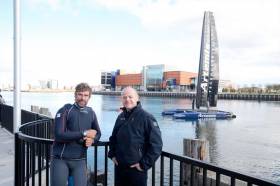Displaying items by tag: Artemis Technologies
Artemis Technologies’ Belfast-based bid for a carbon-free yacht-building project is in line for major seed funding, according to Sail World.
As previously reported on Afloat.ie, the company spun off from America’s Cup team Artemis Racing and led by double Olympic gold medalist Iain Percy announced plans last October to bring shipbuilding back to Belfast Harbour.
The company is developing an Autonomous Sailing Vessel or ASV, a 45-metre catamaran with a top speed of 50 knots, powered by renewables which will offer it unlimited range.
Percy said last year: ““We aim to lead in the decarbonisation of the maritime industry by building on our America’s Cup heritage and expertise in hydrofoils, wing sails and control systems to develop and manufacture green-powered commercial vessels, helping to ensure a sustainable maritime future.”
Artemis Technologies has now secured early-stage funding to pursue a full bid for UK Research and Innovation’s Strength in Places Fund.
Successful projects will receive anywhere from £10 million (€11.65 million) to £50 million (€58.3 million) to see their concepts through to fruition.
Percy described the new funding as “a major endorsement of our plans to make Belfast the advanced maritime manufacturing capital of the world.
“The city is already home to some of the most advanced aerospace and composite engineering talent available anywhere on the planet and we want to harness that potential by combining it with Belfast's rich maritime history and our own expertise in high-speed yacht design.”
Sail World has more on the story HERE.























